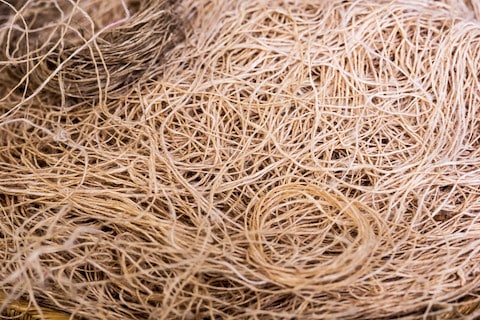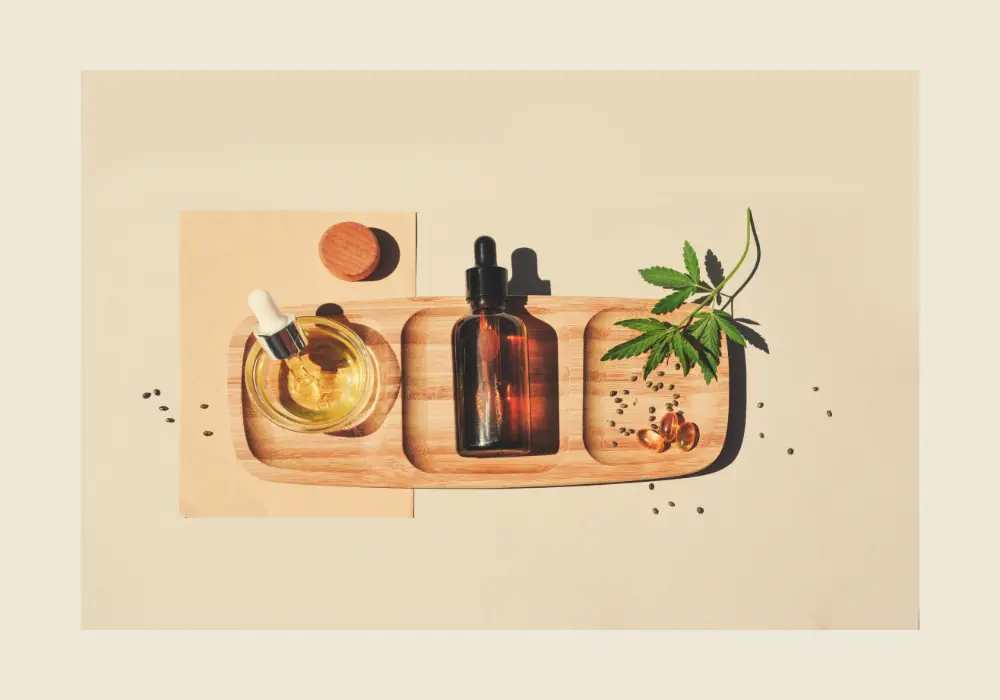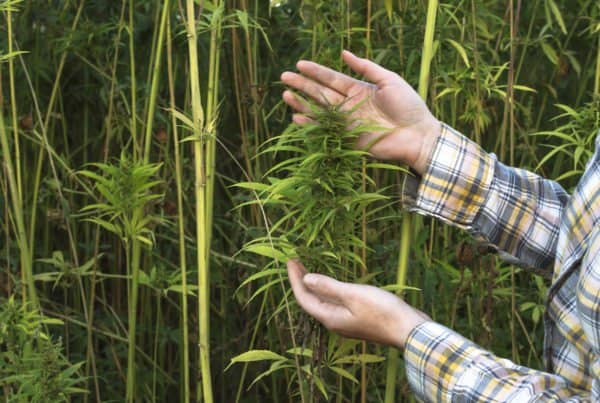TABLE OF CONTENTS
You may not believe it, but hemp fiber has been in use for thousands of years. It’s been used to make all sorts of things from ropes to clothes and even paper. We'll explore its uses, properties, and benefits.
Hemp Fiber Characteristics
Un-processed hemp fiber has a brown or dark tan appearance. While it can be dyed in various bright or dark colors, it is hard to bleach.
Fabrics made from hemp have a lustrous feel similar to linen. Individual fibers differ in length, depending on their intended purpose. Industrial fibers can be many inches long, while domestic-use fibers can be as short as 3/4 of an inch.
Hemp fibers do not stretch. Unlike cotton, hemp fibers are more resistant to UV radiation, so they offer better protection from harsh sunlight and are less likely to fade. Organic hemp fiber is breathable and biodegradable.
Hemp fiber is four to five times stronger than cotton and is also much stronger than steel. It has a maximum tensile strength of 4200 MPa.
Benefits of Using Hemp Fiber
Cost Efficiency
Hemp fiber costs less to acquire because the hemp plants from which it is derived gave minimal growth requirements. They grow fast and yield 5-10 tons of fiber pulp per acre in about 120 days.
Strength
Bulk hemp fibers are robust, and so are the fabrics made from them. They are also breathable, lightweight, and absorbent.
It is Versatile
Hemp fibers may be combined with different kinds of materials like cotton, wool, silk, and Tencel to enhance their properties.
Environmentally Friendly
Hemp farming needs only minimal amounts of water (half the requirement for cotton), it does not require herbicides, and its by-products are ideal raw materials for renewable energy.
The plants also absorb remarkable amounts of carbon dioxide from the atmosphere. Hemp textile processing and paper manufacturing are considered carbon-negative industries.
Hemp Yarn Production Process
Step 1: Harvesting
Hemp fiber quality depends on what purpose the plants are grown to serve. Dual-purpose crops produce fiber and seed, with the seed being utilized for biofuel, food, and other functions.
Hemp plants explicitly grown for fiber will produce a higher grade of fiber than mixed-use plants.
The time it is harvested also affects fiber quality. When harvesting hemp for fiber, it’s advised to cut down the plants 70-90 days after planting, long before seeds are formed.
So, are hemp seeds weed?
No, they aren’t. Hemp seeds come from hemp plants, not Marijuana, so they contain only trace amounts of THC. They are not psychoactive, so they cannot get you high.
Step 2: Hemp Retting
Retting involves using moisture and microbes to degrade the substance that holds the stem together, allowing easy separation of the bast from the hard core. It may be done in several ways that include:
Field retting – the hemp stems are exposed to the elements, which erodes the bonds keeping the bast and core together.
Water retting – the stalks are fully immersed in water, which speeds up the rate of decay of the pectin bonds.
Note: for a long time, hemp stalk processing has been a manual process due to negative public perceptions and bans on cannabis growing. But, things have changed. There are now several automated systems that simplify the process.
Step 3: Fiber Separation
The hemp stalks are passed through fluted rollers, which crush and break the hurd into small pieces. Although it was once laborious, the process has been simplified through decorticators (also known as retting machines).
Next, the hurd is skutched to separate the hemp fibers from the unwanted materials. The fibers are then graded and sold.
Hemp Price per Kg
Hemp fiber companies will buy your product at between $250 and $300 per ton, which translates to 27 – 33 cents per Kilogram.
Uses of Hemp Fiber
Textile manufacturing
Since ancient times, hemp fiber has been used to make textiles. It is easy to obtain and cultivate, and it is also a lot more ecologically friendly than chemically synthesized materials. Hemp fabrics are suitable for people with sensitive skin and don’t cause allergic reactions.
Construction
Fibers from the hemp plant's woody core can be used to make Hempcrete, a building material similar to concrete that’s made by wet mixing hemp hurds with lime-based binders and water. The mixture is then cast into molds or applied directly as a wet loose-fill material that hardens when dry.
Hempcrete may be molded into rectangular blocks and used to construct non-load bearing walls or combined with other building materials to build roofs and floors.
Hemp Shoes
Hemp shoes offer a natural and comfortable alternative to leather and other artificial materials.
Hemp shoes have natural anti-bacterial properties, and they're breathable. This means they don’t retain odors like other synthetic materials, so they're the ideal type of footwear if you'd like to keep your feet smelling fresh.
Since they're made from hemp, it's improbable you'll suffer any adverse reactions from using hemp footwear.
Composite Materials
Hemp fiber is often combined with flax, and kenaf and fiberglass to create composite panels for cars and other objects.
Papermaking
Hemp fiber is an excellent raw material for paper and is often used to make specialty papers like banknotes, cigarette paper, and technical filter paper.
Compared to wood pulp, hemp can yield up to four or five times more fiber with higher tensile strength and resistance to tearing.
Hemp also has a much faster yield. It takes between 3 and 4 months for hemp stalks to get adult hemp plants, yet trees take between 20 and 30 years.
Besides growing at a faster rate than trees, hemp also has a higher cellulose content. This means it can produce paper at a faster rate than wood.
“
There are over 300,000 jobs in the cannabis industry. CTU trained me for one of them!

Makes $24.50 @ THC +
Hemp Jewelry
Hemp ornaments are made by knotting hemp twine to create a variety of attractive patterns and designs. This art, known as macramé, dates back hundreds of years, and it's used to make necklaces, bracelets, rings, anklets, watches, and other adornments.
Ropes
Although it is not as popular as it once was, “cannabis rope” is still commonly used worldwide. Hemp fibers have remarkable tensile strength, multiplying when they're woven together in the rope-making process.
Hemp ropes are durable, resistant to mold and ultraviolet light. They are also friendlier to the environment than synthetic alternatives.
Conclusion
Hemp fiber is an incredibly versatile material with several useful applications. Its growing popularity means it’s an excellent investment idea.
To learn more about hemp farming, enroll in Cannabis Training University today!

Gavin Kushman
Gavin is a worldly adventurer and cannabis connoisseur, embarking on journeys that take him to the far corners of the globe to explore and document the varied effects, flavors, and histories of both renowned and lesser-known strains. From the misty high-altitude farms of the Hindu Kush highlands to the vibrant cannabis cafes of Amsterdam, Gavin's quest for knowledge spans continents. A recognized authority in the cannabis industry, he frequently lends his expertise to leading publications such as Cannabis Training University, where his captivating blog articles chronicle his unique experiences with different cannabis strains.












 Jeff was involved in an accident where he endured a traumatic brain injury. He had a week-long stay in ICU where brain surgeons
Jeff was involved in an accident where he endured a traumatic brain injury. He had a week-long stay in ICU where brain surgeons  100% risk free money back guarantee within 48 hours after purchase if student has not completed any of the courses or exams.
100% risk free money back guarantee within 48 hours after purchase if student has not completed any of the courses or exams.